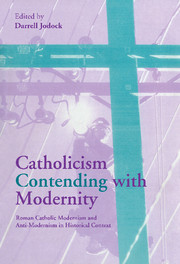 Catholicism Contending with Modernity
Catholicism Contending with Modernity Book contents
- Frontmatter
- Contents
- List of contributors
- Acknowledgments
- List of abbreviations
- Note on the text
- Introduction I: The Modernist crisis
- Introduction II: The Modernists and the anti-Modernists
- PART I THE LATE NINETEENTH-CENTURY SETTING OF MODERNISM AND ANTI-MODERNISM
- 1 Vatican foreign policy and the origins of Modernism
- 2 Catholic anti-Modernism: the ecclesial setting
- 3 Theological and philosophical Modernism
- PART II MAURICE BLONDEL AND ALFRED LOISY IN FRANCE
- PART III FRIEDRICH VON HÜGEL AND MAUDE PETRE IN ENGLAND
- PART IV SOCIAL MODERNISM AND ANTI-MODERNISM IN FRANCE
- Conclusion
- Index
1 - Vatican foreign policy and the origins of Modernism
Published online by Cambridge University Press: 30 October 2009
- Frontmatter
- Contents
- List of contributors
- Acknowledgments
- List of abbreviations
- Note on the text
- Introduction I: The Modernist crisis
- Introduction II: The Modernists and the anti-Modernists
- PART I THE LATE NINETEENTH-CENTURY SETTING OF MODERNISM AND ANTI-MODERNISM
- 1 Vatican foreign policy and the origins of Modernism
- 2 Catholic anti-Modernism: the ecclesial setting
- 3 Theological and philosophical Modernism
- PART II MAURICE BLONDEL AND ALFRED LOISY IN FRANCE
- PART III FRIEDRICH VON HÜGEL AND MAUDE PETRE IN ENGLAND
- PART IV SOCIAL MODERNISM AND ANTI-MODERNISM IN FRANCE
- Conclusion
- Index
Summary
Consalvi, Antonelli, Rampolla: one could write a fascinating and rich history of nineteenth-century Europe through the eyes, and above all the work, of the Vatican's secretaries of state. These ministers helped form foreign policy throughout Europe's various governments, made decisions based on information and the artful gauging of the future's likely course, and worked together with the foreign ministers of secular states to forge a common political course, where possible, to ensure not only peace but above all survival and political stability.
The twentieth century, however, standing in the shadow of 1870 and the demise of the Church State as a meaningful political base for the Vatican's policies, has not been so productive. A history of the Roman Catholic Church in this century, making use of its secretaries of state as a point of departure, would be a thin story indeed. Merry del Val, Gasparri, Pacelli, Casaroli: compared to their counterparts in the preceding century, the achievements are few, if any, the embarrassments many, and the lack of an effective, respected policy, or set of policies, noteworthy. Rather than cooperatively forming the basic guidelines for actual political decisions, and thus events, in Europe and elsewhere, these now almost faceless ministers found themselves trapped by the lack of any stable political power base: the disappearance of the Church State in 1870 led to the bloodletting of the “war” with Bismarck, the draining struggle with France, and the internecine battle over Modernism; in turn, these moments led to this century's straitjacket of the Lateran Treaties and surrender of the German concordat. As Rilke noted in this century's first decade, who speaks these days of victory? Survival is everything.
- Type
- Chapter
- Information
- Catholicism Contending with ModernityRoman Catholic Modernism and Anti-Modernism in Historical Context, pp. 31 - 55Publisher: Cambridge University PressPrint publication year: 2000
- 1
- Cited by
